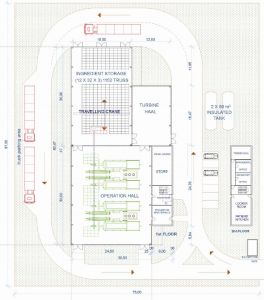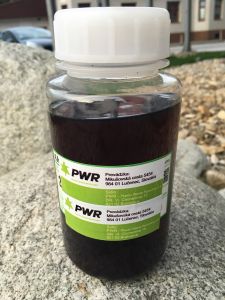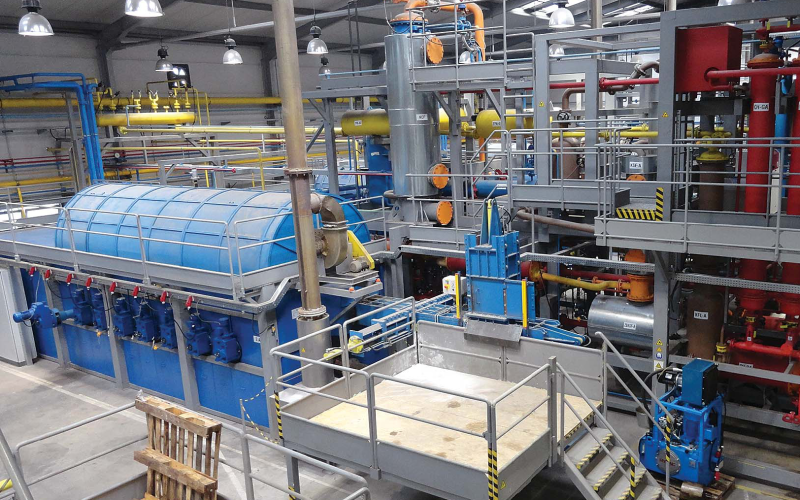The process described below, is a system which processes and transforms plastic waste into liquid energy. The equipment is capable to process plastic waste that cannot be recycled in any other way. The result of the recycling is a liquid hydrocarbon composition which can either be further utilized as a fuel for vehicles and combustion systems or raw material for chemical industry to be processed or rectified. The present method of processing enables cost economic and environmental friendly recycling of community or industry origin plastic waste that would otherwise be a huge environmental exposure.
In the process of development of our technology we focused not only on economic and safety concerns but environmental friendly treatment of community/industry waste that otherwise would generate harmful and hazardous exposure to the environment. Unlike various other recycling processes, our technology fully complies with all the requirements of European Union directives and regulations. Herewith we want to underline that in an effort on focusing on proper and safe operation, our firm provides commissioning of equipment and training of operating personnel as part of the system’s put into operation. Our firm undertakes catalyzer supply, quarterly service and maintenance of equipment and optional developments in a long-term contract; thus the pieces of equipment always represent state-of-the-art and highly productive processes.
This is a recycling process which transforms waste plastics into liquid source of alternative energy that is applicable as industrial raw material.
The process described below, is a system which processes and transforms plastic waste into liquid energy.
The equipment is capable to process plastic waste that cannot be recycled in any other way. The result of the recycling is a liquid hydrocarbon composition which can either be further utilized as a fuel for vehicles and combustion systems or raw material for chemical industry to be processed or rectified.
The present method of processing enables cost economic and environmental friendly recycling of community or industry origin plastic waste that would otherwise be a huge environmental exposure.
In the process of development of our technology we focused not only on economic and safety concerns but environmental friendly treatment of community/industry waste that otherwise would generate harmful and hazardous exposure to the environment.
Unlike various other recycling processes, our technology fully complies with all the requirements of European Union directives and regulations.
Herewith we want to underline that in an effort on focusing on proper and safe operation, our firm provides commissioning of equipment and training of operating personnel as part of the system’s put into operation.
Our firm undertakes catalyzer supply, quarterly service and maintenance of equipment and optional developments in a long-term contract; thus the pieces of equipment always represent state-of-the-art and highly productive processes.
- TECHNOLOGY
This plastic waste recycling process is a catalytic method where the materials are transformed in an air-tight environment at a temperature in the range of 420 °C to 490 °C.
Plastic waste first melts then starts boiling in the equipment at atmospheric pressure. Carbon atoms absorb and transform into chark on the surface of the continuously supplied catalyzer.
In the so called cracking process carbon atoms separating from the chains disengage from the structures causing their decomposition.
This is called polymer degradation. The process results in a linear chain hydrocarbon mixture, i.e. oil that is featured with the relatively high percentage of light fractions.
T-Technology® system with parallel cyclic supply of the two (2) reactors processes a volume of 480,000 kilograms to 560,000 kilograms plastic monthly resulting in a volume of 250,000 kilograms to 350,000 kilograms output, that is a compound of fractions C8 – C34.
The system is easy to operate. Running the system is cost economic and does not require a high number of operating personnel. A condition of installation is a smaller building that complies with normal industrial safety and fire prevention requirements.
Due to the applied procedure, i.e. T-Technology® the depolymerisation process is fully supervised and controlled digitally. The computer control always ensures optimal parameters to system operation.
The efforts of our group of companies are supported with our broad scale of experiences and regular cooperation with internationally recognized experts. We collaborate exclusively with reliable subcontractors and suppliers in manufacturing of T system.
Our developments and practical experiences gained with operating systems enable us to continuous improvement and extension of our technology to the re-use of other organic waste.
1.1. A EQUIPMENT OPERATION
Figures identify the following system elements:
- Raw material store 2. Manual feed 3. Rectifier 4. Stack 5. Heating system heat exchanger 6. Reactor 7. Rectifier system heat exchanger 8. Heating system 9. Cleaning system heat exchanger 10. Cleaning system final storage 11. Finished product store 12. Inspection & Control system
Plastic waste is supplied to the catalytic depolymerisation reactor at the gate. Solid fraction is collected in the interim storage of the cleaning system. Vapours of plastics and synthesis gas are separated to fractions as required in the rectifier unit. The synthesis gas preheated with natural gas goes to the burner of the heating system. Fumes provide the thermal energy to the reactor. The residual heat is gained by the heat exchanger of the rectifier and the heating system. The end product stored in the plastic oil storage tank can either be sold or consumed.
1.2. EQUIPMENT LAYOUT
PCP installation contains doubled reactors. The above chart shows the logistics of raw materials transport and finished products removal on the road map of the premises. Turbine room accommodates machinery of energy utilization (incl. gas turbine, boiler, steam generator, steam turbine, steam motor, generators, transformer, thermal-electric heat exchangers, etc.). The management and social facilities occupy the first floor and second floor of the building.

1.3. STEPS OF TECHNICAL PROCESS
The material is transformed within the reactors. The system runs round the clock, i.e. 24 hours a day and even as many as three hundred days a year including maintenance and cleaning cycles. The process includes the below listed steps:
(A) Supply of required volume of material to process to the premises.
(B) Preparation of received raw material in order to meet the specifications (enabling to ensure good end product quality and continuous production).
(C) Supply of raw material via the hydraulic press system.
(D) Continuous polymer degradation process.
(E) Storage and delivery of end products to customers.
(F) Assurance of required maintenance and operational efficiency of auxiliary equipment.
1.4. RAW MATERIALS
Raw materials the process is capable of processing can come from various sectors of the industry including but not limited to information technology, crude oil processing, electronics, food industry, chemical industry, construction industry, cosmetics industry or pharmaceutical industry.
Waste, i.e. raw materials are primarily polyolefin, like polyethylene (PE) or polypropylene (PP). The scale of recyclable waste is broad including both the products we use every day and those used for special purposes.
Examples of raw materials the system is capable of handling are but not limited to the following:
- One-time use bags and sacks;
- Packaging of detergents and cosmetics;
- Packaging of food;
- Parts of household gadgets;
- Radio/television parts;
- Toys;
- Parts of computers/office equipment;
- Parts of storage boxes/tanks/pipes made of plastics, cable insulations;
- Industrial fabrics;
- Vehicle parts (e.g. bumpers, dashboards, battery cabinets).
Raw materials applied in the described process shall meet the following requirements in order to enable the end product meet applicable quality standards:
Acceptable:
- Mineral pollution below or equal to 5 percent (incl. sand, dust, glass, minor metallic particles);
- Humidity below or equal to 10 percent;
- Printed legend on plastic packaging;
- Different colour/structure/thickness packaging materials;
- Various used PE or PP products;
- PE or PP products mixed in different extent;
- Aluminum coated plastic films.
Not Acceptable:
- Any other pollution/contamination or other organic composition which includes chlorine, (halogens), nitrogen, sulphur and carbonyl group.
(Excellent quality of end product can only be ensured if the raw material meets the pollution requirements specified.)
Diagram: Material balance of the T-Technology® system. The specified pollution percentage represents an average.
- POLYETHYLENE /POLYPROPYLENE
In order to achieve the highest possible quality the utilization of raw material that contains broad range of polyolefin plastic waste is recommended. Examples are:
Polyethylene (-CH2-CH2-)n – industrial mark is (PE)
- (High density PE) – HDPE, Numeric code 02;
- (Low density PE) – LDPE, Numeric code 04;
- (Linear is, Low density PE) – LLDPE.
Polyethylene is a product of ethylene polymerization. Examples are packaging, bags, insulations, cables, acid-resistant wires, construction industry or chemical industry applications, toy components, or components of household gadgets.
Polypropylene (-CH2-CH(CH3)-)n – (PP),
- Numeric code 05;
- A-tactic, iso-tactic, syndic-tactic.
Polypropylene is a product of propylene polymerization. Given the fact that it can resist high mechanical loads and extreme weather conditions they are used by chemical industry or food industry as cables, packaging materials or various other products.
 2. END PRODUCT
2. END PRODUCT
The end product of catalytic transformation of T-Technology® system is registered in the Register of Industrial Products and Services in Poland under the identification code of 24.66.32-90.00.
The end product is a mixture of hydrocarbons which fits for the purpose of fuel, or raw material of household chemicals or other chemicals (petroleum, wax, paraffin, solvents, and thinners).
Detailed laboratory test of the end product concluded the following:
The product does not contain sulphur or chloride; thus it is valuable for
various industrial sectors.
It is composed of hydrocarbons with relatively high number of methyl
group (-CH2).
It does not contain significant volume of aromatic components (benzene is not identifiable);
It does not contain any component that would be composed of carbonyl and alcohol containing groups; no presence of double or triple bonds.
Fractions of hydrocarbons of different boiling points can be separated with rectification. Rectifier unit is available to the equipment as an option.
Assuming that the total output represents 100 % the recommended percentages of fractions are the following:
15%-20 % of 300°C to 360°C (e.g. wax);
60%-70% of 220°C to 280 °C ˚ (e.g. light fuel oil);
15% to 20% of 105°C to 140°C (e.g. thinner).
Direct current/Alternating current.
Manufacture of a significant volume of technical alcohol via using the decarbonisation catalyzer and thermal-electric heat exchanger.






